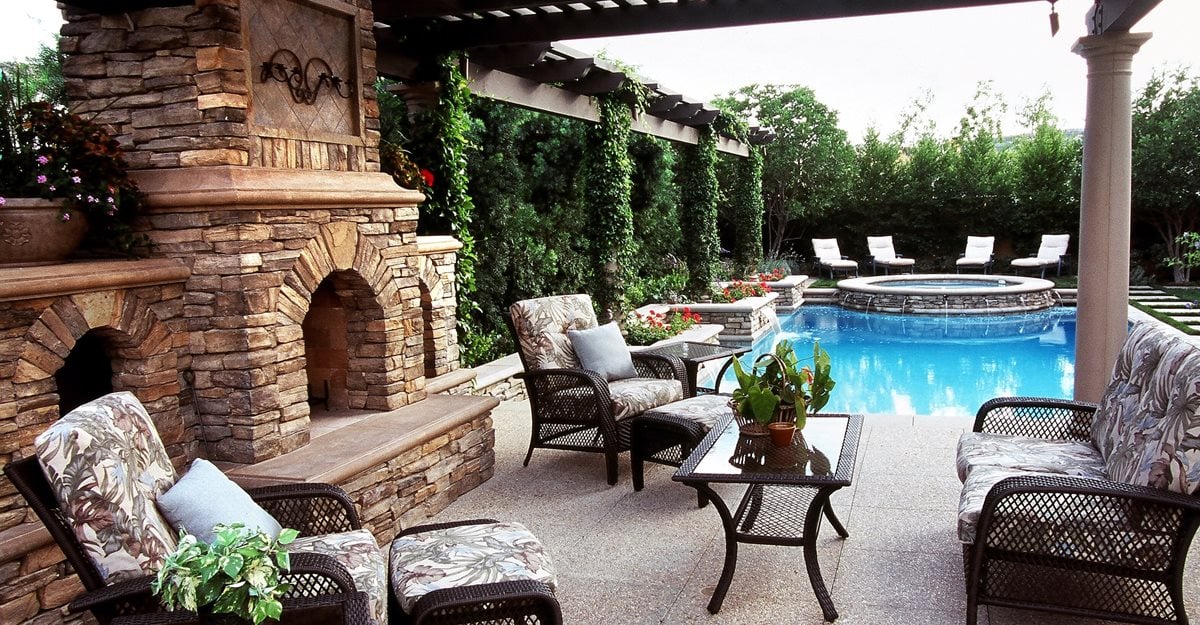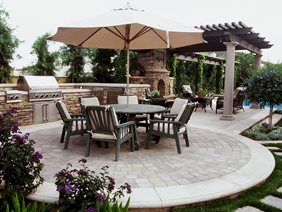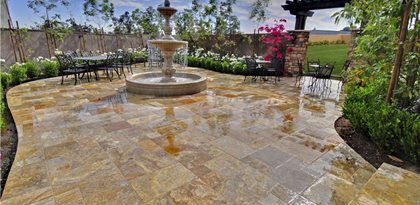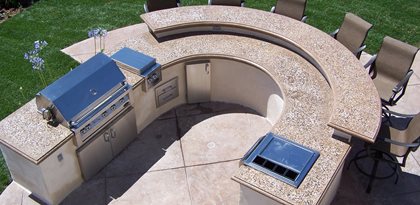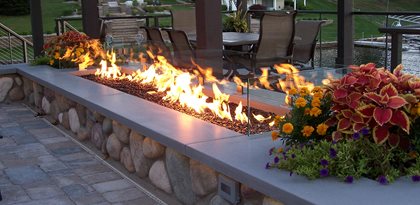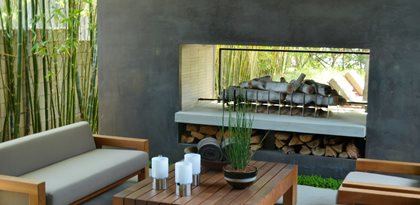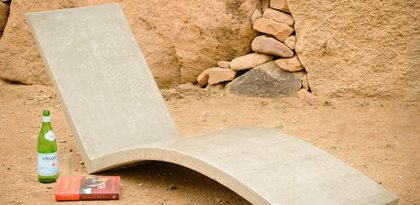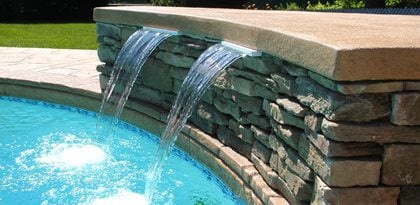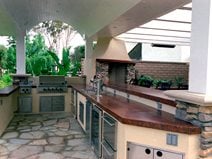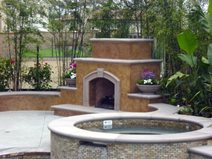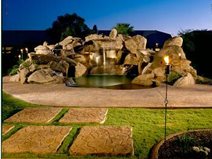- Outdoor Living Space Ideas
- Top trends in outdoor concrete design
- Outdoor room checklist (PDF)
- Fire Pit or Fireplace?
- Ways to Enhance Outdoor Rooms
- Outdoor fireplaces
- Fire pits
- Concrete fire bowls and tables
- Outdoor kitchens and countertops
- Seat walls
- Outdoor concrete furniture
- Concrete planters
- Backyard Landscaping with Concrete
- Concrete patios
- Concrete curbing
- Stairs and steps
- Concrete walkways
- Concrete garden bridges
- Water features
- Architectural accents
- Concrete statuary
- Backyard Landscaping: Get more ideas from LandscapingNetwork.com
- Backyard Recreation Options
- Concrete pool decks: Design and layout tips
- Concrete tennis courts: Planning and construction
- Other Resources
- Outdoor Decorative Floors
- Free Outdoor Living Catalog
Outdoor Living Space Ideas That Wow
Enhance your outdoor living areas with beautiful spaces for gathering with family and friendsThe backyard is taking over as the favorite gathering space for family and friends. The outdoors have become hubs for cooking, entertaining and relaxation. More homeowners are bringing all the comforts of their indoor rooms to the outside by creating multipurpose outdoor living spaces that function as inviting extensions of their homes.
 Concrete Patios
Concrete gives you the creative freedom to create a stylish backyard patio.
Concrete Patios
Concrete gives you the creative freedom to create a stylish backyard patio.
 Fire Pits
See a variety of outdoor fire pit designs and compare custom styles.
Fire Pits
See a variety of outdoor fire pit designs and compare custom styles.
 Outdoor Concrete Trends
Discover four hot decorative concrete trends that will help you create an outdoor retreat.
Outdoor Concrete Trends
Discover four hot decorative concrete trends that will help you create an outdoor retreat.
Thanks to its versatility and ability to withstand all types of weather, decorative concrete is expanding the possibilities of outdoor living. Concrete can be used to build nearly every structural element of a beautiful outdoor room, including patios and pool decks, countertops and sinks, pizza ovens and fireplaces, built-in seating, architectural accents and water features. What's more, decorative concrete permits homeowners to match the colors, textures and styles of the elements inside their homes and create seamless visual transitions.
Find nearby decorative concrete contractors to help with your outdoor living space.
Check out these ideas for using concrete to design and build an outdoor room that enhances the beauty and usability of your home and brings style to your outdoor entertaining.
Here's what we'll cover:
- Tips for planning your outdoor living area
- Outdoor living pictures
- Elements of an outdoor space
- Do's and don'ts for a successful outdoor room
- Eco-friendly ideas for your backyard landscape
TIPS FOR PLANNING YOUR OUTDOOR LIVING AREA
Creating a truly functional and relaxing room for outdoor living requires careful planning. Just as when designing an indoor space, you'll need to consider architectural style, color harmony, traffic flow, space requirements and comfort. Plus, an outdoor room has its own special challenges, such as providing for privacy and creating shelter from the sun and wind.
Determine the size and layout of your outdoor space. This will largely depend on what activities you want to accommodate and the size of your property. Whether your outdoor room is small and intimate or large and spacious, you'll want to create zones to separate various activities—such as cooking, conversation and relaxation—while allowing for good traffic flow throughout the space. When situating your outdoor room, also consider the natural elements such as prevailing winds and sun orientation. Read more about dimensions for outdoor room size.
Complement your home's architectural style. The patterns and colors possible with decorative concrete are unlimited. Narrow down the options by choosing a design scheme that harmonizes with your home and landscape and echoes the design of your indoor rooms. Get ideas for home styles.
Create a room with a view by orienting seating areas to overlook flowerbeds, water features and other attractive scenery.
Get tips for proper orientation and layout.
Plan for privacy. Your outdoor room won't have walls, so if privacy and noise are concerns, you'll need to install a fence or tall landscaping plants between you and the neighbors. For design continuity, consider installing a precast concrete fence or screening wall with a decorative stone or brick pattern that complements your concrete patio.
Consider convenience. Your outdoor room should be easily accessible from the house, with food preparation and outdoor dining areas located near your indoor kitchen to reduce trips back and forth. Also consider access to power and water.
Provide a sheltered retreat. Awnings, umbrellas, gazebos, and pergolas supported by decorative concrete columns are all ways to shelter your outdoor guests from harsh sunlight and light rain while creating intimacy.
Take it in stages. If you're on a tight budget, you can build your outdoor room in stages, starting with a decorative concrete patio and a concrete countertop for serving food. You can install other features later, such as an outdoor fireplace, a decorative concrete fountain, landscaping and lighting.
Get help pulling it all together. Work with a landscape architect and decorative concrete contractor to make your design ideas reality. These professionals can help you plan an outdoor room that matches your budget, aesthetic and functional requirements.
For more design ideas:
Free Outdoor Living Design Catalog
Outdoor Living Design Ideas: Project Profiles of Outdoor Rooms
OUTDOOR LIVING PICTURES
Select a category below to open up a photo gallery:
ELEMENTS OF AN OUTDOOR SPACE
Today, almost any activity you enjoy inside your home you can bring to the outside. Depending on your budget, your outdoor room can be simple, with a stamped concrete patio, a grill and a table for dining, or more elaborate with a fully functional outdoor kitchen complete with concrete countertops for preparing and serving food, a sink and a refrigerator. You can take the concept even further by adding such amenities as a concrete pizza oven, a fireplace or firepit, a concrete bartop for serving cocktails, an architectural concrete fountain, landscape lighting and concrete statuary.
Here are ways to use concrete to build the basic elements of your outdoor space:
Decorative Concrete Surfaces
Start by installing stamped, stenciled or stained concrete patios and walkways to establish the basic floor plan and design scheme for your outdoor room. You can even pattern your outdoor floor with a permanent, weatherproof rug that adds visual interest and helps define dining and conversation areas.
See:
Concrete Patios | Outdoor Concrete Carpet | Pool Decks | Concrete Walkways and Sidewalks
Cooking
Something to cook with, such as a barbecue grill or wood-fired pizza oven, and countertops for food preparation and serving are key elements in a well-designed outdoor kitchen. Concrete countertops offer the advantages of weather resistance and versatility, since they can be formed into any shape you desire to suit the space. A coat of sealer will simplify cleanup by protecting your countertop from stains. Other amenities, such as concrete bartops and outdoor sinks with plumbing, can expand your entertainment options.
Hearth
Something to cook with, such as a barbecue grill or wood-fired pizza oven, and countertops for food preparation and serving are key elements in a well-designed outdoor kitchen. Concrete countertops offer the advantages of weather resistance and versatility, since they can be formed into any shape you desire to suit the space. A coat of sealer will simplify cleanup by protecting your countertop from stains. Other amenities, such as concrete bartops and outdoor sinks with plumbing, can expand your entertainment options.
Furniture
No outdoor room is complete without ample patio furniture for dining and lounging. Attractive high-quality outdoor furniture also provides a smooth transition from the indoors to the outdoors and helps define the space as an extension of your home. Concrete seat walls and cast concrete couches or chaises, softened with pillows or cushions, can be used as permanent, weatherproof outdoor seating. Dining tables can also be precast with concrete.
Water features
If space and budget allow, installing a concrete swimming pool, spa, waterfall or pond can provide beauty, relaxation and tranquil sounds.
Architectural accents
Add elegance and character to your outdoor room with decorative details such as concrete statuary, fountains, landscape borders and cast stone columns.
See:
Concrete Statuary | Concrete Landscape Borders | Concrete Architectural Accents
Lighting
Use pathway and landscape lighting to add ambience, accentuate key architectural features, and extend outdoor enjoyment well into the evening.
DO'S AND DON'TS FOR A SUCCESSFUL OUTDOOR ROOM
Concrete offers endless possibilities for creating spectacular outdoor living environments. But with so many options, it's essential that you establish some goals, stick with a plan, and stay within your budget. You also need to consider some of the basics that often get overlooked, like good traffic flow, the architectural style of your home, space requirements, providing for privacy, and the placement of trees and landscape plantings. To avoid some common mistakes in outdoor room design and to create a functional, comfortable space that takes full advantage of everything decorative concrete has to offer, pay attention to these do's and don'ts.
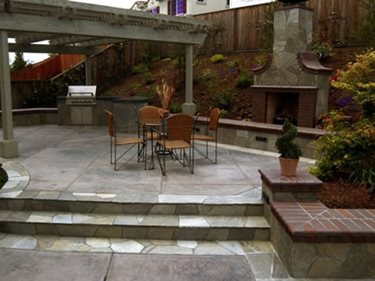 BCP Concrete in Pleasanton, CA
BCP Concrete in Pleasanton, CA
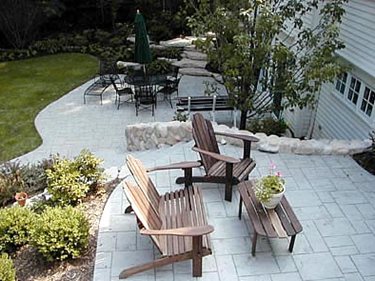 Ortega's Concrete in Plainfield, IL
Ortega's Concrete in Plainfield, IL
Design Don'ts
- Don't start without a plan. Determine the size and layout of your outdoor space and create zones to separate various activities-such as cooking, conversation and relaxation. When situating your outdoor room, also consider the natural elements such as prevailing winds and sun orientation.
- Don't be one-dimensional. The most appealing and functional outdoor rooms take advantage of terracing and steps, which can help maximize a small space, create visual drama, and provide separate levels for various activities.
- Don't forget to add greenery to provide balance and shading for your concrete hardscape. Trees are the best option for providing natural shade, but they can take years to mature. Another option is to install a vine-covered pergola.
- Don't assume that bigger is always better, especially if you have a small space to work with and you're on a tight budget. A small concrete patio can still make a big impact, and you can always add more elements to your outdoor room later, as your budget allows.
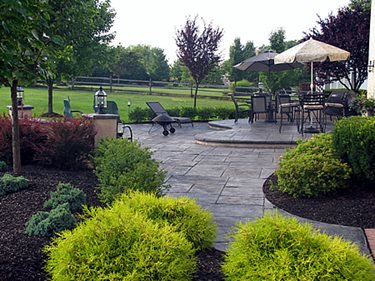 Concrete Impressions in Richboro, PA
Concrete Impressions in Richboro, PA
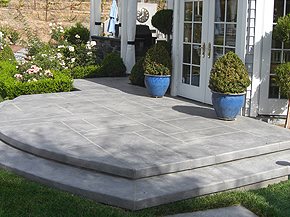 Lasting Impressions in Concrete in Petaluma, CA
Lasting Impressions in Concrete in Petaluma, CA
Design Do's
- Do complement your home's architectural style. Choose a hardscaping design scheme that harmonizes with your home and landscape and echoes the design of your indoor rooms.
- Do improve traffic flow by installing attractive concrete paths and walkways that guide people throughout your space and lead to various focal points.
- Do create a room with a view by orienting seating areas to overlook flowerbeds, water features and other attractive scenery.
- Do add concrete statuary and other architectural concrete accents, such as fountains, garden bridges, and bird baths. These pieces will help to balance the lush floral beauty of your garden, providing structure, contrast and decorative interest-even after the blooms fade.
- Do get help pulling it all together. Work with a landscape architect and decorative concrete contractor to make your design ideas reality. These professionals can help you plan an outdoor room that matches your budget, aesthetic and functional requirements.
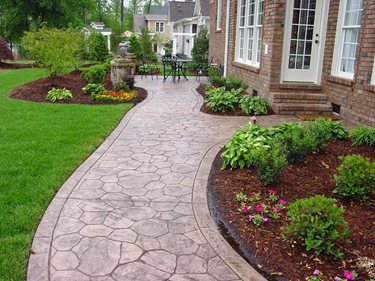 QC Construction Products in Madera, CA
QC Construction Products in Madera, CA
 Campania International
Campania International
ECO-FRIENDLY IDEAS FOR YOUR BACKYARD LANDSCAPE
Being environmentally conscious has never been more at the forefront of homeowners' minds. One area where many homeowners are especially concerned is in the home landscape. More people want to create yards that are not only beautiful and comfortable, but environmentally friendly as well.
There are many ways to weave environmentally friendly elements into your landscape design. Here are a few strategies for being kind to the environment and still enjoying an inviting outdoor space.
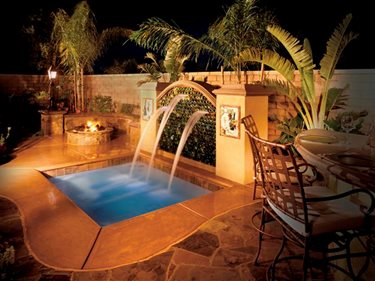
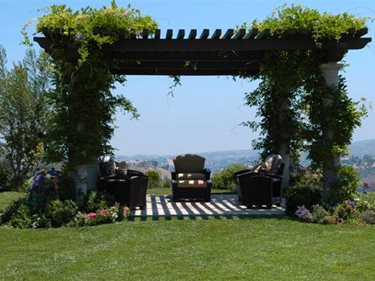
Strategic Planting
Plan for the right plantings in the right places in your backyard. Select and place trees to provide a low energy, comfortable environment shading both the indoors and out. Deciduous trees on the west or south side of your home will help control both summer and winter energy costs. In the summer, your home will be shaded from the heat of the sun. And in the winter, the trees will lose their leaves letting the warmth of the sunshine fill your home.
For your patio cover, consider installing a vine-covered pergola instead of a solid roof. The pergola is another low energy way to keep cool, and this 'living roof' provides shade much more effectively. Plants can actually help cool their surroundings through a process known as transpiration. The plants will release water through their leaves during hot weather, keeping people nearby cool and fresh. Some good deciduous, flowering vines are wisteria. A wisteria-covered roof will adapt to the seasons and will add fragrance to your outdoor area.
Incorporate Recycled Materials
Find new uses for materials that would otherwise be hauled away. Gardens provide a wonderful opportunity for creating artistic elements from recycled materials. For example, you can use recycled glass in your designs. Scott Cohen, owner of Green Scene Landscape, uses recycled wine bottles to build colorful waterfalls, walls, and counters. You can also use broken glass in countertops.
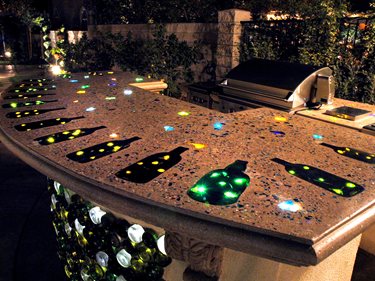
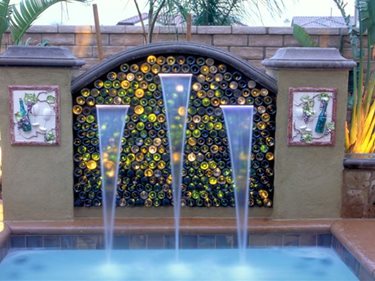
Recycling can be incorporated into just about every aspect of landscape installation. For example, if you have an old concrete patio, driveway, or walk removed, don't bring it to a landfill. Many companies process recycled concrete into a substitute for crushed stone, which has a number of valuable uses in the landscape. Also, look into using recycled mulch made from shredded urban forest products for your planting beds, trails, and playground areas.
Practice Water-Wise Landscaping
Studies continue to show that most landscapes are vastly over-watered. Do your part by incorporating a water conscious design. One of the best ways to do this is to group plantings with similar water requirements. For example, if you put the lawn on one zone, thirsty plants on another zone, and drought tolerant plants on a different zone, you can water each at different rates. If you don't, you'll usually end up over-watering many plants while trying to meet the needs of a thirsty few.
Be choosy in the type of irrigation system you install. Some controllers include highly efficient water saving features such as being programmed to communicate with local weather stations and automatically adjusting watering schedules based on the weather. Also, using low volume sprinklers on the lawn and drip systems in your beds will help in using less water. These products are designed to deliver smaller amounts of water at rates tailored to specific plant needs. Because they don't water faster than plants absorb it, they promote lush plant growth with minimal runoff.
Portions of this article courtesy of: www.greenscenelandscape.com
